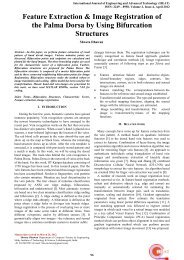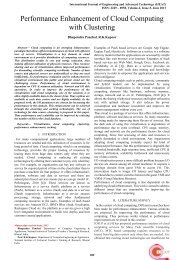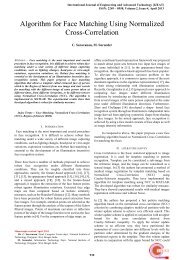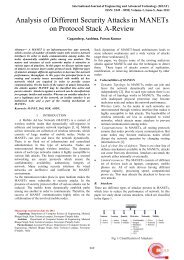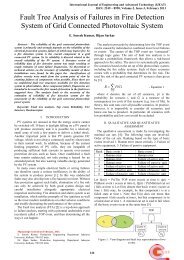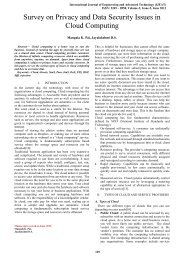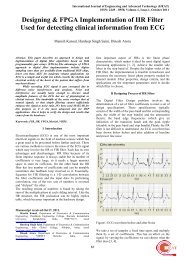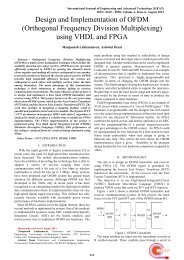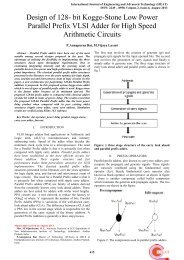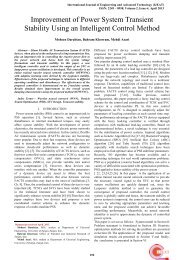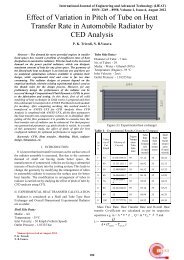<strong>High</strong> <strong>Level</strong> <strong>Clones</strong> <strong>Classification</strong>A. Behaviour <strong>Clones</strong>Juergens et al. [9] call two pieces <strong>of</strong> code behaviourallyequal, if they have the same sets <strong>of</strong> input and outputvariables and are equal with respect to their functioninterpretation. So, for each input valuation they have toproduce exactly the same outputs.. Kwon [10] describesbehavioural clones to depict similar run time behaviour.These can be detected as: if any two programs having sameDirected Acyclic Graph (DAG) modeling data dependencyor same control flow dependency, then they are behaviourclones <strong>of</strong> each other. Simply we can say that if two codesgive similar output by giving same input then they can callbehaviour clone. This is not necessary that they arerepresentationally same. They may or may not berepresentationally same. Such type <strong>of</strong> clone could berepresented by our example <strong>of</strong> swapping two variablevalues, Figure 2(a), 2(b) shows different representations <strong>of</strong>this example but they all give similar output <strong>of</strong> figure 2(c).templates”. Design patterns and mental templates (or"skeletons") <strong>of</strong> how a program should work, also fall underthe category <strong>of</strong> concept clones. Mental templates reflectcommon programming wisdom or programmer’s specificexperiences.C. Structural <strong>Clones</strong>These clones may be defined as similar program structuresthat are formed by lower level, smaller clones, with similarcode fragments (i.e., conventional clones described inliterature) at the bottom <strong>of</strong> such hierarchy. This concept <strong>of</strong>moving from lower level similarities to higher levelsimilarities can be repeatedly applied, leading to thediscovery <strong>of</strong> design concepts at various levels <strong>of</strong> abstraction.Basit[12] visualizes example <strong>of</strong> structural clones as in Fig 3.Figure 2 (a): Swap Nnumbers by Using Bitwise operatorFigure 2 (b): Swap Nnumbers by Using Temporary VariableFigure 2 (c) Output <strong>of</strong> Figure 2(a) and 2(b)B. Concept clonesFrom the experience <strong>of</strong> Marcus [11], these clones manifestthemselves as higher level abstractions in problem orsolution domain like an ADT (Abstract Data Type) list. It isworth noting that the high level concept for which the cloneis being detected depends on the user’s understanding <strong>of</strong> thesystem. Their detection is improved with internaldocumentation and program semantics, where a semanticsimilarity is defined in terms <strong>of</strong> similar input and outputconditions. Design solutions repeatedly applied byprogrammers to solve similar problems are called “mentalFigure 3 : Structural <strong>Clones</strong>This considers a group <strong>of</strong> simple clone configurationsrecurring rring in files X1, X2 and X3 a file-level structural cloneset. These file level structural clone set form collaborative(via message passing) structures <strong>of</strong> structural clones. Basit[13] describe how structural clone analysis extends thebenefits <strong>of</strong> analysis based on simple clones only and discussthe concept that structural clones covers all kinds <strong>of</strong> largegranularity repeated program structures.D. Domain model clonesThese are similarities in UML domain models like Classdiagram, ER diagram, Use case diagram etc. It is likely thatat some point, the overall model will contain duplicatefragments <strong>of</strong> sub models or model elements i.e. modelclones, as per Harald. [14]. <strong>Clones</strong> in UML domain modelscan cause a problem during model based development,hence it is important to detect them. This is best possiblethrough application <strong>of</strong> any <strong>of</strong> the reverse engineering tool,followed by domain expert’s knowledge.Case Study: Hospital Management SystemHere a case study <strong>of</strong> Hospital Management System is takento show UML diagrams to detect the clones at design leveland then removing them. The Hospital Management Systemprovides relevant information across the hospital to supporteffective decision making for patient care and hospitaladministration.The HOSPITAL MANAGEMENT SYSTEM (HMS) coversmany hospital activities. Every hospital big or small keepsthe records <strong>of</strong> its patients including the registration details <strong>of</strong>the patient and the fee payments. Patients are categorized asIn Patients and Out Patients. The entry <strong>of</strong> patients isdetermined whether he has arrived in emergency, OPD orfor a routine check-up. The patient who gets admitted isprovided with a room according to his/her choice. Thepatient is allotted a doctor according to his illness. The383
<strong>International</strong> <strong>Journal</strong> <strong>of</strong> Engineering and Advanced Technology (IJEAT)ISSN: 2249 – 8958, Volume-2, Issue-6, August 2013doctor may refer the patient to another doctor with expertise<strong>of</strong> the illness. On discharge, the patient is required to settlethe bills sent by the accounts department <strong>of</strong> the hospital.Out Patient module keeps the record <strong>of</strong> outdoor patients. Ithas various features like adding new patient details,searching, updating or deleting patient records, preparingmedical bill, keep track <strong>of</strong> patient records and also the billreports.In Patient module keeps the record <strong>of</strong> admitted patients. Ithas various features like adding new patient details,searching, updating or deleting patient records, preparingmedical bill, keep track <strong>of</strong> patient records and also the billreports. It also keeps record <strong>of</strong> discharged patients.Figure 2. Use case Diagram <strong>of</strong> InPatient and outpatientcategoryThis Figure shows the use case diagram <strong>of</strong> the category <strong>of</strong>patients- InPatients and OutPatients. It can be seen thatinpatients and outpatients have same behavior and commonattributes. Visualizing these we can see that they are actuallyclones to some extent. So we can easily detect these clones.Figure 5. Class Diagram <strong>of</strong> InPatient and OutPatient ClassThis Figure shows a representation <strong>of</strong> a part <strong>of</strong> the HospitalManagement System highlighting the class structures <strong>of</strong>InPatient and OutPatient Class. In both the classes namedInPatient and OutPatient It is seen that there are occurrences<strong>of</strong> common methods and variables. The method getDetailsand various attributes like name, id, age, contact and othersthat are identical in both classes InPatient and OutPatient.III.CONCLUSIONS AND FUTURE WORKS<strong>of</strong>tware clones appear at various levels- simple clones aresimilar program fragments, in respect <strong>of</strong> similarity; whilestructural clones may be viewed as collaborations <strong>of</strong> lowerlevel (simple) clones. A high level clone is an attempt tomove towards high level similarity patterns, yet firmlyrooted in patterns <strong>of</strong> concrete similarities at implementationlevel. A structural clone may indicate a cloned concept (inthe requirements or design space). A ‘high level conceptclone’ stems from a similarity in concepts. Detecting highlevel clones is directly related to domain analysis. To findthe relationships between different repeating entities,semantic links between them need to be traced. In additionto code, other related artifacts like design diagrams and codecomments can also be quite useful for locating andanalyzing high level clones. We aim to extend the technique<strong>of</strong> semi automated detection <strong>of</strong> higher level similarities ins<strong>of</strong>tware and present the results in a manner such that theycan be utilized for providing insights into prospectivereengineering (refactoring), reuse or anomaly free updating<strong>of</strong> the system. In future, we aim to expand the high levelclones’ taxonomy by including new types subtypes. We aimto demonstrate benefits <strong>of</strong> high level clone analysis throughmore case studies.REFERENCES[1] H. A. Basit and Stan Jarzabek, “ A Case for Structural <strong>Clones</strong>”,<strong>International</strong> Workshop on S<strong>of</strong>tware <strong>Clones</strong> (IWSC), 2009.[2] B. S Baker , “On finding duplication and near duplication in larges<strong>of</strong>tware system” , proceedings <strong>of</strong> Second IEEE WorkingConference on Reverse Engineering, 1995.[3] William S. Evans , Christopher W. Fraser and Fei Ma, “Clonedetection via structural abstraction” S<strong>of</strong>tware quality journalVolume 17, Number 4, 2009.[4] Cory Kasper and Michael W. Godfrey, “Cloning consideredharmful”, Working Conference on Reverse Engineering ’06, 2006[5] Fowler, M., Analysis Patterns, Addison-Wesley, 1996.[6] Gamma, E., Helm, R., Johnson, R., and Vlissides, J., Designpatterns: Elements <strong>of</strong> reusable object-oriented s<strong>of</strong>tware, Addisonwesley,1997.[7] Jean Mayrand, Claude Leblanc, Ettore Merlo. Experiment on theAutomatic Detection <strong>of</strong> Function <strong>Clones</strong> in a S<strong>of</strong>tware SystemUsing Metrics. In Proceedings <strong>of</strong> the 12th <strong>International</strong> Conferenceon S<strong>of</strong>tware Maintenance (ICSM’96), pages. 244-253, Monterey,CA, USA, November 1996.[8] Balazinska, Merlo, Dagenais, Lague, Kontogiannis. MeasuringClone Based Reengineering Opportunities. In Proceedings <strong>of</strong> the 6th<strong>International</strong> S<strong>of</strong>tware Metrics Symposium (METRICS’99), pages292-303, Boca Raton, Florida, USA, November 1999.[9] E. Jürgens, F. Deissenboeck, and B. Hummel: Code SimilaritiesBeyond Copy & Paste, in proceedings <strong>of</strong> CSMR, pages 78-87,2010.[10] T. Kwon and Z. Su. Modeling high-level behavior patterns forprecise similarity analysis <strong>of</strong> s<strong>of</strong>tware. In UC Davis techical reportCSE-2010-16,2010.[11] Marcus, A., and Maletic, J. I. : Identification <strong>of</strong> high-level conceptclones in source code. in proceedings <strong>of</strong> the <strong>International</strong>Conference on Automated S<strong>of</strong>tware Engineering (ASE), pages 107-114, 2001.[12] H. A. Basit, Damith C. Rajapakse and Stan Jarzabek : Structural<strong>Clones</strong>-<strong>High</strong>er-level Similarity Patterns in Programs, SIGSOFTSymposium on the Foundations <strong>of</strong> S<strong>of</strong>tware Engineering, ACMPress, May, Lisbon, 2005.[13] H. A. Basit, Usman Ali and Stan Jarzabek : Viewing Simple <strong>Clones</strong>from Structural <strong>Clones</strong>’ perspective, in IWSC, Honolulu, 2011[14] Harald S. Towards clone detection in UML domain models, pages285-293,2010[15] T. Kwon and Z. Su. Modeling high-level behavior patterns forprecise similarity analysis <strong>of</strong> s<strong>of</strong>tware. In UC Davis techical reportCSE-2010-16, 2010.[16] E. Jürgens, F. Deissenboeck, and B. Hummel: Code SimilaritiesBeyond Copy & Paste, in proceedings <strong>of</strong> CSMR, pages 78-87, 2010[17] M. Zibran and C. Roy. The Road to S<strong>of</strong>tware Clone Management: ASurvey. Tech. Report 2012-03, Department <strong>of</strong> Computer Science,University <strong>of</strong> Saskatchewan, Canada, pp. 1{62, 2012.384



